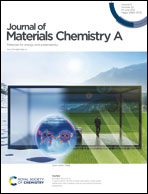Bimetallic oxyhydroxide in situ derived from an Fe2Co-MOF for efficient electrocatalytic oxygen evolution†
Abstract
Metal–organic frameworks (MOFs) have received extensive attention as a research hotspot in the field of electrocatalytic water splitting. However, the study of electrochemical in situ formation of catalysts to improve the activity for the OER is far from being satisfactory. In this work, we prepared a Fe2Co-MIL-88B MOF on nickel foam (Fe2Co MOF/NF) through a solvothermal process. Fe0.67Co0.33OOH was in situ formed on the surface of an Fe2Co MOF during the OER, which is confirmed as the real active species. The electrocatalytic performance is significantly improved due to the electron transfer between Fe and Co, which is confirmed to be related to the positive coupling effect between Co and Fe and the change of the electronic structure caused by the replacement of Co by Fe metal ions in the MOF. Meanwhile, density functional theory calculations reveal that the OER on Fe0.67Co0.33OOH follows the Mars–van-Krevelen mechanism. The electrochemical test results show the superior OER activity of the catalyst with a low overpotential of 224 mV at a current density of 10 mA cm−2, a low Tafel slope of 45.3 mV dec−1, and excellent stability for 50 hours in 1 M KOH. This study provides a simple and effective strategy for the rational design and structural evolution of MOF-derived materials to achieve inexpensive and effective electrocatalysis.



 Please wait while we load your content...
Please wait while we load your content...